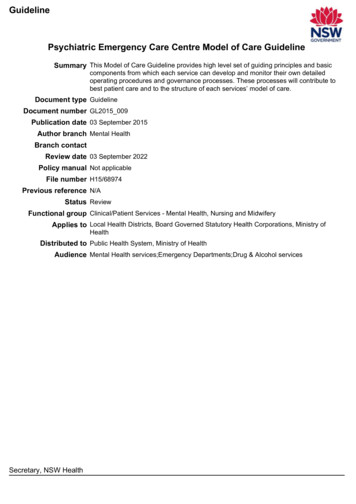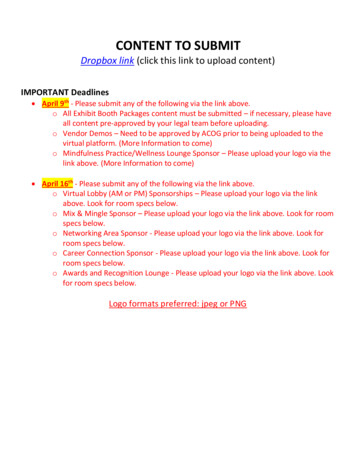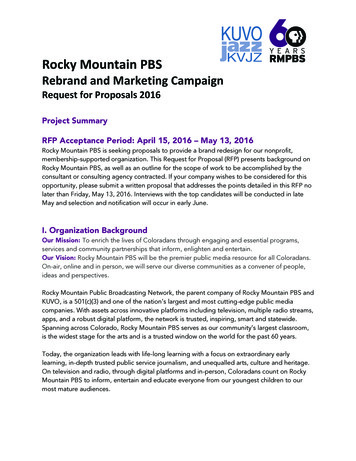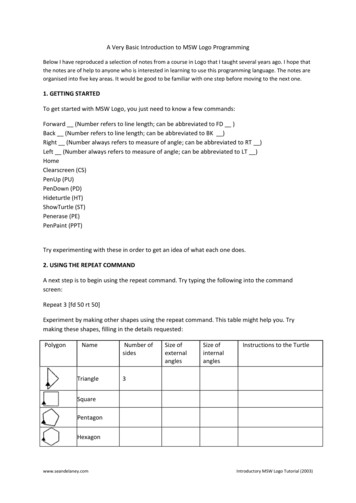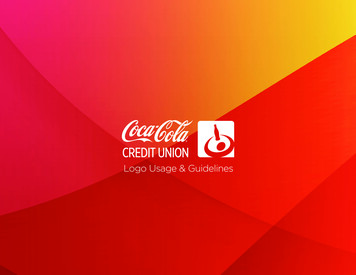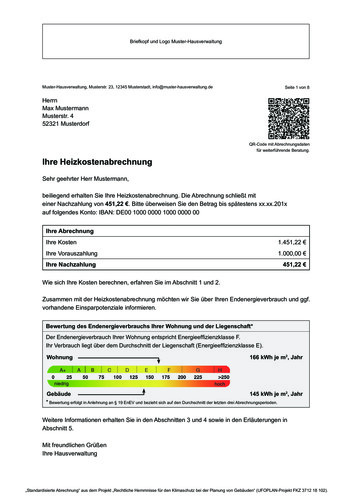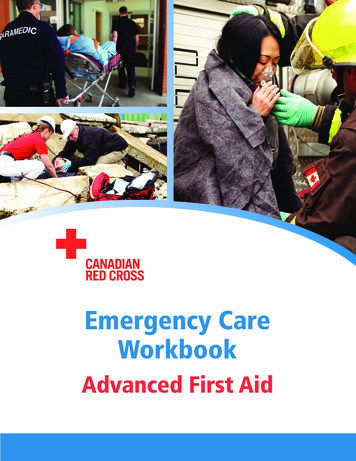
Transcription
Emergency CareWorkbookAdvanced First Aid
EMERGENCY CAREWORKBOOK
Copyright 2012 The Canadian Red Cross SocietyAll rights reserved. No part of this publication may be reproduced, stored in a retrieval system, or transmitted, in anyform or by any means, electronic, mechanical, photocopying, recording, or otherwise, without prior written permissionfrom The Canadian Red Cross Society. Permission is granted to current Training Partners, currently certified CanadianRed Cross Instructors, and participants of Canadian Red Cross First Aid Programs to reproduce and transmit this publication for the purposes of instructing and completing the Canadian Red Cross First Aid Programs.This publication is available in English and French.The terms “he” and “she” have been used throughout the document to ensure representation of both genders.Composition by JEZ GraphicsIllustrations by Scott MooneyProduced in Canada by:The StayWell Health Company Ltd.2 Quebec Street, Suite 107, Guelph ON N1H 2T3A part of Krames StayWell Strategic Partnerships Division780 Township Line Road, Yardley, PA 19067-4200 USA
!The First Aid Attendant . 4The Emergency Scene . 7Preventing Disease Transmission . 13Anatomy and Physiology . 16Secondary Survey . 20Choking . 26Respiratory Emergencies . 27Airway and Ventilation . 30Circulatory Emergencies . 38Cardiopulmonary Resuscitation . 41Bleeding, Shock, and Soft Tissue Injuries in the Workplace . 51Musculoskeletal Injuries . 58Head and Spine Injuries . 62Chest, Abdominal, and Pelvic Injuries . 65Sudden Illnesses . 67Poisoning . 73Heat- and Cold-Related Emergencies . 76Special Populations and Crisis Intervention . 79Childbirth . 84Reaching and Moving Patients . 87Multiple Casualty Incidents . 92Communications and Transportation . 96
The First Aid AttendantFor Your ReviewRead Chapters 1 and 25 of Emergency Care, then complete the following activities.Key TermsReferring to Emergency Care, define the following terms:Abandonment:Confidentiality:Consent:Duty to act:Emergency medical responder (EMR):Emergency medical services (EMS) system:First aid attendant:Good Samaritan laws:Interpersonal communication:Material Safety Data Sheets (MSDSs):Medical control:Negligence:Refusal of care:Workplace Hazardous Materials Information System (WHMIS):Emergency Care Workbook4Copyright 2012 The Canadian Red Cross SocietyStandard of care:
While you are driving to work one morning, you seesomeone has fallen off his bicycle and seems to be bleeding from his leg quite severely. As you get closer, younotice that the bike is badly damaged and the person hasseveral cuts and scrapes all over him.1. In this situation, do you have a duty to act? If so,why? If not, why not?2. If you do decide to act in this situation, your firstconcern should be to:a. Bandage the woundsb. Determine if there are any other injuries youcan’t seec. Ensure your safety and the safety of anybystandersd. Call work and tell them you will be late3. What types of hazards may be present? What canyou do to protect yourself from these?Test Your KnowledgeCircle the best answer to each of the following questions.1. Which of these is not a level recognized by theParamedic Association of Canada?a. Primary care paramedicb. Initial care paramedicc. Critical care paramedicd. Emergency medical responder2. As a first aid attendant, you should have good communication skills. Which of the following people isa first aid attendant least likely to need to communicate with?a. The ill or injured person and his familyb. His partner or co-workersc. Bystandersd. The lawyer of the ill or injured person3. When obtaining consent before caring for someone, which of the following do you NOT have to do?a. Have the person sign the Acceptance of Treatmentformb. Identify yourself with your namec. Indicate what you think may be wrong and whatyou plan to dod. State your level of training4. All documentation should be:a. Perfectly handwritten, accurate, and withouterrorb. Bulleted, with the diagnosis clearly indicatedc. Legible, professional, and completed. Typed, on time, and signed by the ill or injuredperson5. Ending care of an ill or injured person without hisconsent, or without ensuring that someone withequal or greater training will continue the care, iscalled:a. Abandonmentb. Refusal of carec. Transfer of functiond. Competence6. What are the first two critical actions that someonefrom the general public should take in an emergency?a. Recognize that an emergency exists and beginprompt careb. Recognize that an emergency exists and obtainmore advanced medical carec. Obtain more advanced medical care and movethe ill or injured person out of any hazardous situationsd. Transport the ill or injured person to a hospitaland wait until the family arrivesEmergency Care Workbook5Copyright 2012 The Canadian Red Cross SocietyWhat Would You Do?Read the following scenario and answer the questionsbelow.
8. If you are speaking with a physician, it is importantthat you:a. Write down everything he saysb. Repeat any orders back to the physicianc. Present all information rapidlyd. Verify that everything said by the physician islocated within your written protocols9. Which of the following should you keep in mindwhen using a radio?a. Speak slowly and clearlyb. Begin speaking at the same time you push the“push to talk” buttonc. Hold the radio right up to your mouthd. Relay all information you have collected at thescene up to that pointCopyright 2012 The Canadian Red Cross Society7. Which of the following is NOT a common component of a radio system?a. Base stationb. Mobile radiosc. Global positioning system unitsd. RepeatersEmergency Care Workbook6
The Emergency SceneFor Your ReviewRead Chapter 2 of Emergency Care, then complete the following activities.Key TermsReferring to Emergency Care, define the following terms:Emergency move:Hazardous materials:Do You Know 1. What hazards do you see at this scene?3. At the site of a collision, list the three situations inwhich you might park in a roadway to block traffic.i.ii.iii.4. List the five key elements a responder should payattention to when approaching an emergencyscene.i.ii.iii.iv.v.Copyright 2012 The Canadian Red Cross Society2. What would you do to control this scene?Emergency Care Workbook7
Fill in the Blanksiv.SituationPrecautionsa. Check doors before openingthem, stay close to the floor,avoid using elevatorsb. Ensure the scene is safe,avoid touching anythingunless it hinders care,document everythingc. Put up reflectors, flares, orlights well back from thescene, for visibilityd. Look for placards on transportation vehicles, cluessuch as spilled substances,leaking containers, orunusual odourse. Get directions from theincident commander; triageappropriatelyWhat Would You Do?Read the following scenario and answer the questionsbelow.You arrive at the scene of a motor vehicle collision. Onecar is perched on its side, and on the other side of theroad, a truck has hit a large tree, snapping the trunk andcausing the top of the tree to be angled over the truck.1. Ideally, what personal protective equipment shouldyou wear to ensure your safety at the scene?i.ii.v.2. As you approach the scene, you see a placard indicating a flammable substance is on board. Which ofthe following would be an appropriate action totake?a. Open the truck doors and investigate what thesubstance isb. Ensure that the appropriate services to deal withhazardous materials have been notifiedc. Have bystanders gather buckets of water in caseof fired. Check to see if any houses nearby have a chainsaw so you can cut down the tree3. Appropriate resources are on the scene, dealingwith the truck and directing traffic. You are clear tobegin necessary treatment. The truck driver appearsuninjured, and he exits the truck on his own power,where another responder tends to him. You nowmake your way to the car and its passengers. Whatshould be your first step?a. Climb into the car to assess the peopleb. Ask the people in the car to climb outc. Ensure the car has been stabilizedd. Gather people to help you roll the car uprightTest Your KnowledgeCircle the best answer to each of the following questions.1. Which of the following is NOT a primary responsibility of the responder at an emergency scene?a. Ensure safety for yourself and any bystandersb. Gain access to the patient(s)c. Contact the friends and/or family of the patientd. Determine any threats to the patient’s life2. If there is a downed electrical wire at an emergencyscene, how far away should the bystanders bemoved?a. Twice the length of the span of the wireb. There is no specific place to which they should bemovedc. Half the distance between the two poles fromwhich the broken wire has been strungd. The distance from the break in the wire to theclosest power poleiii.Emergency Care Workbook8Copyright 2012 The Canadian Red Cross Society1. Complete the TableFill in the situations that correspond to each appropriate set of precautions to take.
3. If you are in a burning building, which is the bestway to get out safely?a. Cover your mouth and nose with a moist clothand walk to the nearest exitb. Jump out the nearest windowc. Cover your mouth and nose with a moist clothand stay close to the floord. None of the above4. Which of the following are clues that a hazardousmaterial may be present at an emergency?a. Chemical transport tanks and/or placardsb. Clouds of vapour or spilled solids or liquidsc. Unusual odoursd. All of the above7. To have an effective plan of action, which of the following are crucial?a. Advanced care training and a large humanresource baseb. Advance preparation and periodic rehearsalc. A complex medical communication networkd. Specialized equipment and vehicles8. When pulling someone out of deep water, it isimportant to:a. Enter the water and hold onto the patient securelyb. Yell for help as you wade in to get the patientc. Keep as low as possible and use something toreach the patient from a stable pointd. Both a and b5. An emergency that may overwhelm the capabilitiesof an EMS system is called:a. Simple Triage And Rapid Treatment (START)b. Triagec. A multiple casualty incidentd. Critical incident stressCopyright 2012 The Canadian Red Cross Society6. The system used to control and direct the resourcesat an emergency scene is referred to as the:a. Incident command systemb. Simple Triage And Rapid Treatment systemc. Emergency medical services systemd. Dispatch systemEmergency Care Workbook9
Preventing Disease TransmissionFor Your ReviewRead Chapter 3 of Emergency Care, then complete the following activities.Key TermsReferring to Emergency Care, define the following terms:Acquired immune deficiency syndrome (AIDS):Airborne transmission:Bacteria:Blood-borne pathogens:Community-associated MRSA:Direct contact transmission:Hepatitis:Herpes:Human immunodeficiency virus (HIV):Immune system:Immunization:Indirect contact en:Severe acute respiratory syndrome (SARS):Tuberculosis:Vector-borne transmission:Virus:Emergency Care Workbook13Copyright 2012 The Canadian Red Cross SocietyInfectious disease:
Do You Know 1. The four conditions that must be present for aninfection to be transmitted to someone are:i.ii.iii.iv.What Would You Do?Read the following scenario and answer the questionsbelow.You are called to a residence because a 15-year-oldteenager is worried about her grandfather, who has fallen and cut his leg. Upon talking to her, you learn that hergrandfather has been coughing more than usual, and attimes there has been blood on the tissues he uses. Sheattributed this to his age. As you approach him, he iscoughing.1. What precautions, if any, should you take when caring for the grandfather?2. List five precautions you can take to prevent disease transmission:i.ii.iv.v.3. An exposure control plan should include the following elements:i.ii.iii.2. Aside from the cut on his leg, what ailment mightthe grandfather be suffering from?a. Meningitisb. Tuberculosisc. Kidney stonesd. Chickenpox/shingles3. If someone catches an infection from particlesexpelled during coughing, what method of diseasetransmission would this be?a. Direct contactb. Indirect contactc. Vector-borne transmissiond. Airborne transmissionTest Your KnowledgeCircle the best answer to each of the following questions.1. Which of the following can be transmitted by airborne particles?a. HIV/AIDSb. Hepatitis and meningitisc. Meningitis and tuberculosisd. Herpes and tuberculosisEmergency Care Workbook14Copyright 2012 The Canadian Red Cross Societyiii.
2. If you think you have been exposed to an infectiousdisease at an emergency scene, the first step youshould take is:a. Go to a hospital to be testedb. Notify your supervisor and any other responderpersonnel involvedc. Determine what type of disease it isd. Contact the Poison Control Centre3. In which of the following cases should you wear fullprotective equipment (gloves, gown, mask, andeyewear)?a. When wiping down a blood pressure cuff after acallb. When caring for bleeding that is spurtingc. When caring for someone with signs of an infectious respiratory illnessd. Both b and c5. Which of the following are basic components of theimmune system?a. White blood cellsb. Plateletsc. Antigensd. Red blood cells6. Immunizations are available for which of the following diseases?a. Hepatitis A and B, polio, and mumpsb. Herpes, meningitis, and hepatitis Cc. Influenza, rubella, and tetanusd. Both a and cCopyright 2012 The Canadian Red Cross Society4. Which of the following can be transmitted by contaminated food?a. Tuberculosis and rubellab. Typhus and diphtheriac. Meningitis and hepatitisd. Meningitis and herpesEmergency Care Workbook15
Anatomy and PhysiologyFor Your ReviewRead Chapter 4 of Emergency Care, then complete the following activities.Key TermsReferring to Emergency Care, define the following terms:Body system:Cell:Circulatory system:Digestive system:Endocrine system:Genitourinary system:Integumentary system:Musculoskeletal system:Nervous system:Organ:Respiratory system:Tissue:Copyright 2012 The Canadian Red Cross SocietyVital organs:Emergency Care Workbook16
Fill in the BlanksRespiratory System1. Fill in the blanks with the correct body parts andother terminology below.Directional TermsCirculatory SystemCopyright 2012 The Canadian Red Cross SocietyBody CavitiesEmergency Care Workbook17
What Would You Do?Read the following scenarios and answer the questionsbelow.2. “Anatomical position” is:3. Complete the chart below:Body SystemMajorComponentsPurposeSupplies the bodywith oxygenthrough breathingScenario 1While at work at a machine shop, a man is turning apiece of steel on a lathe. The chuck is not tight enough,and when the tool makes contact with the steel, the steelprojects itself toward the man. He puts his arm up toblock his face, and the steel makes a deep laceration inthe back of his upper arm.1. Using correct terminology, describe the location ofthe injury in relation to these other body structures:Bones, muscles,joints, ligaments,tendonsa. Elbow:b. Shoulder:Nervous2. Is the injury superior or inferior to the pelvis?IntegumentaryHeart, arteries,veins, capillaries,bloodEndocrineUterus and genitaliaKidneys and bladder4. Complete the chart below with the names of eachbody cavity and the major structures within eachcavity.Body Cavitya.b.Major Structures in the Cavity3. Which two body systems will interact to alert theman to his injury?a. Nervous and respiratoryb. Endocrine and nervousc. Nervous and integumentaryd. Circulatory and digestiveScenario 2You are called to a school where a teenaged boy is having a severe allergic reaction and has used his prescribedepinephrine auto-injector. He has a MedicAlert medicalidentification product around his neck that indicates hehas a severe allergy to peanuts. The person sitting besidehim in the cafeteria was eating a granola bar.1. Anaphylaxis is a reaction that can affect which ofthe following body systems?a. Nervous, endocrine, and genitourinaryb. Integumentary, endocrine, musculoskeletal, andnervousc. Digestive, respiratory, and genitourinaryd. Integumentary, respiratory, cardiovascular, anddigestive2. Hives or redness of the skin may be the visual signsof anaphylaxis on the skin. What signs may be present that indicate an effect on the digestive system?c.d.e.Emergency Care Workbook18Copyright 2012 The Canadian Red Cross SocietyBreaks down foodand eliminateswaste
Test Your KnowledgeCircle the best answer to each of the following questions.1. The epiglottis prevents liquids and solids fromentering what?a. The stomachb. The lungsc. The esophagusd. The intestines2. Where do arteries carry blood?a. From the heart to the body tissuesb. From the lungs to the heartc. From the heart to the lungsd. Both a and c3. The integumentary system has many functions. Itsmain function(s) is(are) to:a. Prevent infectionb. Secrete hormonesc. Produce white blood cellsd. All of the above4. In comparison with the chest, the neck is describedas , whereas the abdomen isdescribed as .a. Anterior, posteriorb. Medial, lateralc. Superior, inferiord. Proximal, distal5. The respiratory system and cardiovascular systemwork together to:a. Provide oxygen to the cells of the bodyb. Keep hormones distributed throughout the bodyc. Regenerate nervous tissue after injuryd. Regulate blood flow to the digestive system6. Which of the following is not in the pelvic cavity?a. Rectumb. Spleenc. Bladderd. Reproductive organs7. Which of the following is one of the quadrants ofthe abdomen?a. Dorsal quadrantb. Superior quadrantc. Upper midline quadrantd. Right lower quadrantCopyright 2012 The Canadian Red Cross Society3. Epinephrine opens the airway and stimulates theheart to continue beating. Which two body systemsdoes this indicate that epinephrine affects?Emergency Care Workbook19
Secondary SurveyFor Your ReviewRead Chapter 5 of Emergency Care, then complete the following activities.Key TermsReferring to Emergency Care, define the following terms:Blood pressure (BP):Brachial artery:Carotid artery:Glasgow Coma Scale (GCS):Glucometry:Golden Period:Head-tilt/chin-lift:Jaw thrust:Level of consciousness (LOC):Load-and-go emergency:Mechanism of injury (MOI):Primary survey:Pulse oximetry:Respiratory rate:Secondary survey:Secondary transport decision:Signs:Symptoms:Transport decision:Vital signs:Emergency Care Workbook20Copyright 2012 The Canadian Red Cross SocietyRapid body survey:
Do You Know 1. What are the three parts of the secondary survey?i.ii.Fill in the Blanks1. The Assessment ProcessFill in the boxes to show the steps involved inassessment.iii.2. If you need to call for further help, what are theseven pieces of information you will need to tell thedispatcher?i.ii.iii.iv.v.vi.vii.3. If you are not transporting the patient yourself, youwill need to obtain more advanced medical care insome cases. List five conditions in which you woulddo this.i.2. Label the pulse points in the diagram.ii.iii.iv.v.4. List the equipment you would ideally have to completely check vital signs.Copyright 2012 The Canadian Red Cross SocietyEmergency Care Workbook21
ABCABCSAMPLESAMPLEAVPUAVPUOPQRSTOPQRSTAPGAR (See Chapter 20 on childbirth.)APSome other assessment mnemonics you may hear in thefield are:Why might a patient have an altered level of consciousness?AlcoholEpilepsyInsulin /PoisonStroke (cardiovascular)When doing a secondary survey, remember to:Inspect for rationsSwelling/Subcutaneous emphysemaand palpate for eous emphysemaor DCAP and tionsBurnsLacerationsSwellingWhen doing a secondary survey, look for DOTS (signs ofinjury)DeformitiesOpen woundsTendernessSwellingGAREmergency Care Workbook22Copyright 2012 The Canadian Red Cross Society3. Commonly Used Assessment MnemonicsComplete the words or phrases represented by eachmnemonic.
4. Vital SignsFill in the name of the vital sign that corresponds to the number or observation written here.ObservationVital Sign120/72Alert and orientedEqual, round, and reactiveto light14, regular, and deepDilated and fixed93, weak, and irregular130/PPale, cool, and clammyGCS of 13Red, hot, and dry76, regular, and fullUnresponsive5. Assess Your ClassmatesFill in the names of your classmates. Then take the following vital signs and fill in your findings for each classmate.RespirationsPulseSkin CharacteristicsBlood PressurePupilsCopyright 2012 The Canadian Red Cross SocietyNameEmergency Care Workbook23
You are called to the local park, where a child has collapsed in the sandbox. The child is not responsive. Youconfirm that the child is breathing and has a pulse.1. What are the next three steps you should take?i.4. After completing your secondary survey, you perform another vital signs check and observe the following. Put an ‘X’ next to the vital signs that areprobably not normal for this child and a ‘ ’ next tothose that are probably normal.Vital SignNormal vs. Not NormalLevel of consciousness: reactive toverbal stimuliBreathing: 14, strong, and regularii.Pulse: 100, strong, and regulariii.Skin: warm and pink2. You check the child’s vital signs and find the following. Put an ‘X’ next to the vital signs that are probably not normal for this child and a ‘ ’ next tothose that are probably normal.Vital SignNormal vs. Not NormalLevel of consciousness: unresponsiveBreathing: 10, shallow, and regularPulse: 100, strong, and regularSkin: pale, cool, and clammyBlood pressure: 120/60Pupils: equal, round, and reactiveto light3. The child’s babysitter is able to answer any questions you have regarding the child. Which of the following questions should you ask her?a. The child’s sleeping patterns, eating times, andvaccination recordsb. The child’s allergies, current medications, and thelast time the child ate or drank anythingc. The child’s age, address, and where she goes toschoold. The child’s medical conditions, activities beforethe emergency, and normal breathing rateBlood pressure: 110/60Pupils: equal, round, and reactiveto lightTest Your KnowledgeCircle the best answer to each of the following questions.1. If you check capillary refill and the nail bed does notreturn to normal colour after you release, whatdoes this mean?a. The patient has insufficient circulationb. You pressed on the fingernail too hardc. You did not press on the fingernail hard enoughd. The patient’s heart is not beating2. Which of the following should you treat before performing a secondary survey?a. A fracture/sprain of the elbowb. An impaled object through the right handc. Severe bleeding from the left legd. None of these should be treated until after thesecondary survey3. When doing a head-to-toe survey of an unconscious patient, you should:a. Look for medical insurance and check to see ifanyone knows what happenedb. Inspect the arms first as this can give you a goodindication of injuries to the torsoc. Ask the patient to take a deep breath in and thenexhaled. Inspect the patient using sight and touch4. When surveying the scene, which of the followingshould you NOT need to ask yourself?a. Is the scene safe?b. Can bystanders help?c. What might have happened?d. Do I have all the right equipment?Emergency Care Workbook24Copyright 2012 The Canadian Red Cross SocietyWhat Would You Do?Read the following scenario and answer the questionsbelow.
5. When forming a general impression, which of thefollowing do you NOT need to determine?a. If the patient is ill or injuredb. The patient’s gender and approximate agec. If the patient takes any medicationsd. The patient’s chief complaint6. Which of the following would indicate a need formore advanced care?a. A 30-year-old woman who has a bruise on herleg from a soccer ballb. A 50-year-old man experiencing numbness andtingling on the right side of his bodyc. A 10-year-old girl who is crying because of a beestingd. A 65-year-old man experiencing stiffness in hisback after swimming 30 lengths of the pool8. What are the purposes of the primary and secondary surveys?a. Determine if the patient is in shock; identify if thepatient is still in shock or if your treatment hashelpedb. Identify any hazards that are a threat to those atthe scene; determine what else might be wrongwith the patientc. Determine the initial vital signs to compare withduring later monitoring; identify any allergies ormedications the patient might haved. Identify conditions that are an immediate threatto life or could become an immediate threat tolife; identify conditions that are not immediatelylife-threateningCopyright 2012 The Canadian Red Cross Society7. When assessing a child or baby, which of the following should you NOT do?a. Speak loudly and forcefully so she sees that youknow what you are doingb. Use the child or baby’s name and get down toher eye levelc. Approach slowly and allow the child or babytime to get used to youd. Explain what you are doing and allow her toinspect equipmentEmergency Care Workbook25
ChokingFor Your ReviewRead Chapter 6 of Emergency Care, then complete the following activities.Key TermsReferring to Emergency Care, define the following terms:Airway obstruction:Finger sweep:1. What are the two types of airway obstruction?i.ii.What Would You Do?Read the following scenario and answer the questionsbelow.You are called to a restaurant where someone is choking.More advanced care is also on the way. You arrive to findout the choking person has gone into the washroom toavoid embarrassment. The woman is visibly pregnantand quite far along. She is looking pale and anxious andis making high-pitched wheezing sounds.1. After identifying yourself and explaining what youare going to do, you should:a. Get her to lie on the ground and begin chestcompressionsb. Stand behind the woman and begin abdominalthrustsc. Do nothing until she stops making soundsd. Stand behind the woman and alternate betweenfive firm back blows and five chest thrusts2. The woman goes unconscious. You protect her headand lower her to the ground. You open her airwayusing a head-tilt/chin-lift and check for breathingand a pulse. You find she is not breathing but has apulse. You should:a. Attempt to give her a ventilationb. Check for a pulsec. Begin chest compressionsd. Do a finger sweep of the mouth3. At one point, your ventilation goes in and you seethe chest just begin to rise. You should:a. Do 30 chest compressionsb. Give another ventilationc. Roll her into the recovery positiond. Recheck her ABCs4. If you find that the woman is not breathing, but shestill has signs of circulation (including a pulse), youshould give her one ventilation every three to fiveseconds. T or FTest Your KnowledgeCircle the best answer to each of the following questions.1. You are giving care for someone who is unconscious and choking. If your FIRST breath does notgo in, you should:a. Begin chest compressionsb. Attempt another ventilation, with slightly moreforcec. Do a finger sweep of the mouthd. Re-tilt the head and attempt another ventilation2. When performing back blows and chest thrusts ona conscious choking baby, how should you positionthe baby?a. On a flat surface such as a tableb. Turned on her side for easy access to the backand chestc. Resting on your thigh with the head lower thanthe bodyd. Upside down so gravity has the most effectEmergency Care Workbook26Copyright 2012 The Canadian Red Cross SocietyDo You Know
Respiratory EmergenciesFor Your ReviewRead Chapter 6 of Emergency Care, then complete the following activities.Key TermsReferring to Emergency Care, define the following terms:Acute pulmonary edema:Anaphylaxis:Aspiration:Asthma:Breathing emergency:Bronchitis:Chronic obstructive pulmonary disease tion:Metered-dose inhaler (MDI):Pneumonia:Rescue breathing:Respiratory arrest:Emergency Care Workbook27Copyright 2012 The Canadian Red Cross SocietyPulmonary embolism:
Do You Know 1. What are the signs and symptoms of a breathingemergency?2. Respiratory EmergenciesFill in the type of emergency that corresponds toeach description.Type of EmergencyDescriptionAn obstruction in the airwayA narrowing of the air passages2. When is it appropriate to stop rescue breathing?A disease in which carbondioxide/oxygen exchange is noteffectiveSwellin
from The Canadian Red Cross Society. Permission is granted to current Training Partners, currently certified Canadian Red Cross Instructors, and participants of Canadian Red Cross First Aid Programs to reproduce and transmit this publi-cation for the purposes of instructing and completing th

